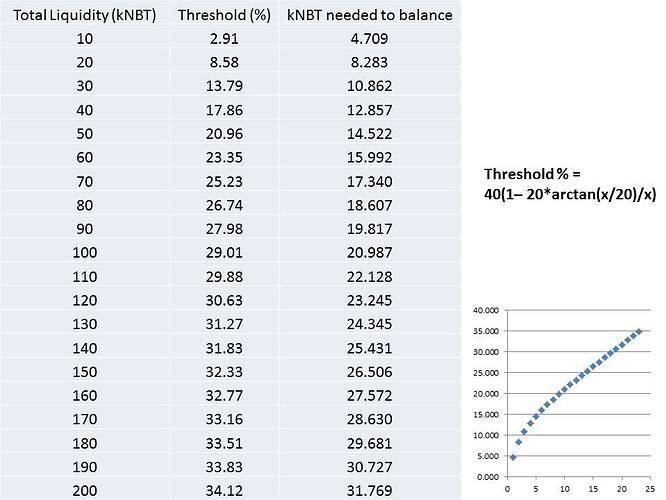I propose that 4 of 7 multisig addresses for NBT, NSR and BTC should be jointly managed by seven community members, known as the First Liquidity Operations Team, or FLOT.
Shareholders should elect individuals to FLOT via motion, with one motion for each signer. If 7 signers are not elected, then 4 of 6 or 3 of 5 multisig will be used. So, the first step will be to elect individual signers. Someone wishing to be a member of FLOT should advance a motion similar to this:
Begin motion
@satoshi shall be one of the members of the First Liquidity Operations Team. @satoshi can be reached via Bitmessage to coordinate signing at BM-2cTWuSKmRZ2gb91A4rbZz5LKEPJxoKVSWy. @satoshi promises to be a part of FLOT for at least one year and to abide by all shareholder motions governing the use of funds. @satoshi will be available for signing at least 5 days a week and 45 weeks a year. No monetary is compensation is required.
End motion
Willingness to continue being part of the team for an extended period is important, because if a single team member quits new multisig addresses will need to be formed.
While voting is progressing on motions that add specific members to the team, the terms of a motion governing how NSR, NBT and BTC will be used can be debated and voting on the motion governing how funds are used can proceed separately.
Here is the finalised and hashed version of the motion governing how funds should be used:
Motion RIPEMD160 hash: f99ddf406a32d39be7d614c13dc1ce63c96e4003
=##=##=##=##=##=## Motion hash starts with this line ##=##=##=##=##=##=
NSRA custodial grant of 25 million NSR should be requested using the FLOT multisig address.
Rules for use of NSR:
⦁ If less than 25% of all liquidity in tiers 1, 2 and 3 across all currencies is on the buy side, NSR should be sold with the goal of restoring buy side liquidity back to 25%. Sale proceeds should be converted to currency if necessary and burned, with the burn transaction IDs announced publicly. Additional details about how much to sell, how much at a time, etc should be determined by the signers in real time, because much more information will be available at that time than shareholders have now. We can be confident in any course of action agreed upon by 4 of the signers.⦁ The rules of NSR sales defined in this shareholder motion and other motions apply to these signers. Briefly, if park rates are offered for more than 30 days consecutively, NSR auctions and currency burns begin.
NBT
A grant of 150,000 NBT should be requested using A FLOT multisig address. The First Strategic Reserve Team (FSRT) will continue functioning as a backup to sell side pressure provided by this group. FSRT has a total of 4,040,000 currently in its possession. All but 151,500 of this should be burned within 14 days of when the NBT grant to FLOT is made. No commission or compensation will be paid for funds burned.
Rules for use of NBT and other Nu currency:
If sell side liquidity in tiers 1, 2 and 3 for a specific currency drop below 40% of total liquidity, signers shall sell currency in the open market until the sell side is restored to at least 40% of total liquidity. Proceeds of currency sale shall be added to tier 4 buy side funds, which may be used for share buybacks as specified by existing shareholder motion.
BTC
All tier 4 buy side funds (currently about 466 BTC) shall be transferred to a multisig address shared by this group.
Rules for use of BTC or other tier 4 buy side funds:
FLOT will be bound by the same rules established by shareholder motion to conduct share buybacks in cooperation with @NSRBuyback. BTC will be used to purchase currency when a specific currency’s buy side funds falls below 40% of total liquidity in tiers 1, 2 and 3 for that currency. The currency proceeds will be placed in the multisig currency address controlled by FLOT.
The preceding should be interpreted as guidelines, and FLOT may exercise discretion. Communications between FLOT members regarding decisions on how to use funds must be publicly visible.
In order to form FLOT, at least 3 signers must be selected by motion. Additional signers will be accepted for a period of 14 days after this motion is passed.
=##=##=##=##=##=## Motion hash ends with this line ##=##=##=##=##=##=
Verify. Use everything between and including the <motionhash></motionhash> tags.
Once the signers have been selected by motion and rules governing the use of funds have passed, signers will construct NSR, NBT and BTC multisig addresses together, which will become the target of NSR and NBT grants. BTC currently held as tier 4 buy side funds will be transferred to the FLOT BTC address.
Of course, I look forward to comments and suggestions about how this can be improved, as well as clarifying questions.
